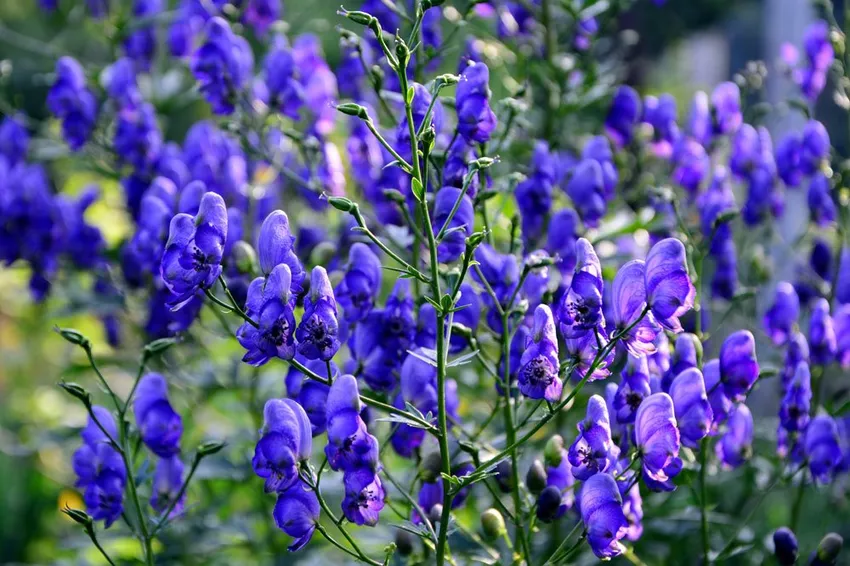Poisonous perennials in the garden can cause symptoms of poisoning in people and especially children. Our list shows 8 highly venomous specimens.
 Perennials in the garden with their sonorous names, magnificent flowers or tempting fruits enchant hobby gardeners and viewers alike. However, some of them contain toxic substances that are a deadly hazard. Small children in particular like to explore their environment in a playful way, and it can happen that they taste leaves, blossoms and fruits without hesitation. A small amount of plant material is enough to cause symptoms of poisoning in children.
Perennials in the garden with their sonorous names, magnificent flowers or tempting fruits enchant hobby gardeners and viewers alike. However, some of them contain toxic substances that are a deadly hazard. Small children in particular like to explore their environment in a playful way, and it can happen that they taste leaves, blossoms and fruits without hesitation. A small amount of plant material is enough to cause symptoms of poisoning in children.1Aconite

The most poisonous of the native perennials is monkshood. It owes its name to the characteristic shape of its flower, which looks like an iron helmet that knights and lansquenets wore as a hood in the Middle Ages. Depending on the variety, monkshood blooms in summer or autumn. Its flowers can shine in the colors blue, light blue, cream or white and make an enticing picture in the perennial border. All plant parts of monkshood are very poisonous.
Applicable Active Ingredients: Aconitine (alkaloid).
Consequences of Poisoning: Hypothermia, Cardiac/Respiratory Paralysis, Convulsions, Death
2Lily of the valley (Convallaria majalis)

The lily of the valley is one of the most popular spring bloomers. It exudes its characteristic scent from May to June. The white flowers are hemispherical in shape. Its medium-green leaves are broadly lanceolate and have a matt surface. The fruit decoration appears from July to September and appears as bright red, pea-sized berries. The poisonous parts of the lily of the valley are its leaves and flowers.
Toxic Agents: Convallatoxin (Cardenolide).
Consequences of Poisoning: Nausea, cardiac arrhythmia and circulatory collapse. Larger doses can be fatal.
3Foxglove (Digitalis )

The foxglove is a clump-forming and stiffly upright perennial. Characteristic are its firm stems, which give the plant an upright, strong hold. The attached, dark green leaves are ovate.The flowers are grape- to trumpet-shaped. Special varieties of foxglove are cultivated in Europe as medicinal plants for life-sustaining heart medication.
Toxic Agents: Digitoxin (Cardenolide).
Consequences of Poisoning: Cardiac arrhythmia, inflammation, nausea, vomiting, visual disturbances, hallucinations.
4Larkspur (Delphinium belladonna)

With its tightly upright inflorescences and its individual flowers in the colors blue, white or pink, the delphinium is a popular bedding perennial among hobby gardeners. Rose lovers put this perennial as a rose cavalier to their 'queens'. The flower of the delphinium has a pointed, spur-like spur above its calyx. This gives the plant its perennial name. All parts of the Delphinium plant are poisonous.
Toxic Agents: Elatin (alkaloid).
Consequences of Poisoning: severe indigestion
5Christmas roses (Helleborus niger)

The Christmas rose is particularly attractive with its cup-shaped, snow-white flowers and the striking yellow stamens. This early-flowering perennial arouses great anticipation for the upcoming garden season from January. The bright flowers of this unique perennial can be admired until April. The leaf is palmate, the leaf margin 'serrated'. The leaf surface is rough to shiny. All parts of the Christmas rose are poisonous.
Toxic substances: Hellebrigenin (bufadienolide)
Consequences of poisoning : severe heart trouble
6Autumn Crocus (Colchicum)

The real autumn crocus grows wild on moderately moist meadows. Cultivated varieties are more likely to be found in the garden. Each tuber produces several flowers, which look great among other autumn bloomers and between half-tall perennials. The pure species is particularly suitable for near-natural plantings, such as in a meadow, where it will become wild over time. All plant parts of the autumn crocus are highly poisonous.
Toxic Agents: Colchicine (alkaloid).
Consequences of Poisoning: Nausea, death from central respiratory paralysis
7Himalayan may apple (Podophyllum hexandrum)

With its bronze-colored shoots, the folded leaves, above which light pink flowers rise, the Himalayan may apple makes a particularly decorative plant in the garden. The palmately lobed leaves turn greengradually and later often show considerable marbling. From the flowers form hen's egg-sized, red, oval fruits, which are poisonous. The rhizomes of the plants are also poisonous.
Toxic substances: Podophyllotoxin.
Consequences of poisoning: Nausea and severe indigestion
8Bittersweet nightshade (Solanum dulcamara)

Bittersweet nightshade is particularly attractive in near-natural gardens by ponds if it can climb into trees there. The rather inconspicuous purple flowers are followed by shiny red berries. The native subshrub is a well-known but highly poisonous medicinal plant. All parts of the plant are highly poisonous, especially the berries, which are attractive to children. The green, bitter fruits contain significantly more toxins than the sweet ones.
Toxic substances: Steroidal alkaloids
Consequences of poisoning: the plant poison can cause death